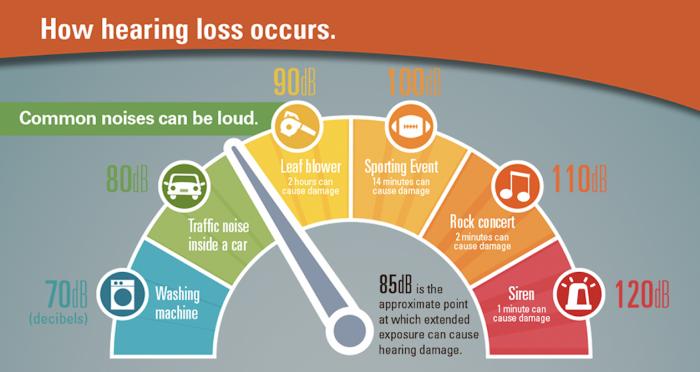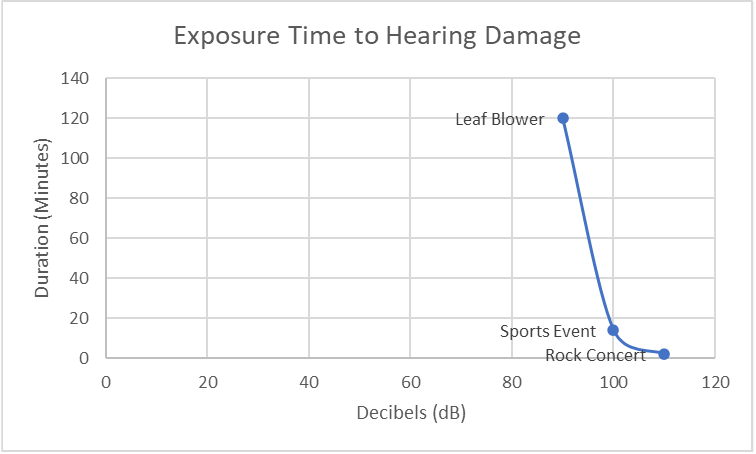Noise Pollution - Understanding the Risks and Effects in Work and Everyday Life


Introduction
Noise, like every other sense, can bring extraordinary amounts of pleasure. On the other hand, too much noise can alter our mental and physical health little by little, and without our knowledge. As civilization grew and our cities expanded, our exposure to noise exponentially increased. Whether you are trying to have a conversation, running your HVAC system, focusing on a task in your city apartment, or attending a concert, it is important to understand the effects of excessive noise on our health.
Unhealthy Noise

It is widely accepted that 85dB (decibels) for extended periods of time is the threshold where noise can turn unhealthy3. Common noise sources and their associated decibels can be found in the resources cited and pictures included, but a gas-powered leaf blower typically sits around 90dB which can do damage around two hours of exposure for reference1. As things get louder it takes less exposure time for damage to occur. For example, a sports event sits around 100dB and can do damage in 14 minutes, whereas a rock concert with only 10 more decibels, at 110 dB, only takes two minutes for damage to occur1.
The simple science behind hearing damage is essentially tiny hairs in the ear are stacked neatly. When sound comes in, bones in the ear vibrant, and that vibration is picked up by the ear hair. Excessive, damaging noise serves as a bowling ball permanently knocking over or rearranging the ear hairs1. It is important to note that damage to ear hairs based on exposure level is exponential. Every increase in noise level is increasingly more dangerous to your health as seen in the graph above.
Other examples of noise sources above 85 dB for your conceptualization are3:
- Traffic: 100 dB
- Aircraft noise (high overhead): 130 dB
- A bustling bar/club: 100 dB
- A howling or barking dog: ~70 dB
Hearing Loss
The first consequence of noise pollution and ear hair damage is, obviously, hearing loss. Hearing loss is not simply a shift in operating thresholds, such as an older speaker having to be turned to higher volumes to be heard, or in this case, a person suffering from hearing loss simply needing everything to be louder in order to hear. The way ear hairs are stacked are conducive to sound vibration and picking up frequencies1. Once the ear hairs are damaged to a certain extent, the sufferer will never be able to hear those particular frequencies again.
.png)
Source: CDC
Hyperarousal
Moving on from the obvious hearing implications, there are also major risks to both your physical and mental health. To start, unhealthy levels and frequencies of noise can cause hyperarousal in most people. Hyperarousal is essentially an unexpected boost of adrenaline. Emphasis on the unexpectedness, hyperarousal is often found in PTSD sufferers. Adrenaline, produced by hyperarousal, is used infrequently by your body to help you focus on life-threatening situations. Lengthy periods of hyperarousal can damage your cardiovascular system, as the system is in overdrive. On top of continually pushing your heart to the limit, there are mental side effects of continuously being “on edge.” Such side effects can be irritability, difficulties concentrating, anxiety and panic, self-destructive behavior, and more2.
Sleep Loss
One of the other symptoms of hyperarousal that was not mentioned before is sleeping problems, because that in its own right, is a symptom of noise pollution. You may have hyperarousal keeping you from falling asleep, and noise pollution keeping from you from staying asleep. It only takes 45 dB (a healthy noise level) to prevent you from falling or staying asleep3. Fortunately, the side effects of poor sleep, such as irritability and poor memory, creativity, judgement and motor skills are widely understood, which means people are more likely to recognize negative health outcomes and moderate accordingly. Regardless of that, if you are suffering from noise pollution while you are trying to sleep the noise source is likely uncontrollable, aka the noise is not coming from you.
Solutions
Overall, the solutions to prevent noise pollution from effecting your health in a noticeable manner are, admittedly, limited. The cheapest, also free, solution is to simply be mindful of the noise around you and your exposure to it. Hearing is a sense that we often find pleasure in, which mean there are ways to indulge in it, such as going to concerts and living a bustling life. We do not need to forsake the things that give us pleasure in the name of health, but we can moderate our exposure to them.
A next step up is to purchase and store noise reudction aids/products such as ear plugs, earmuffs, and noise cancelling headphones. Many of the provided examples of potential noise pollution are inescapable when you live a life outside of your home. Insignificant parts of your day, such as commuting to work in traffic or on a subway likely have consequential effects on your health more than you realize. While most people might not think to carry eag plugs or find them a nuisance, this simple and relatively inexpensive product might make a significant difference to comfort, and to hearing over time.
If you are constantly being affected by noise pollution, specifically in your place of residence or occupation, you may consider investing in extra sound proofing of your spaces. While most people don’t have the financial luxury to consider this option, it can still be a consideration, especially since even most well-off individuals can hardly consider taking the most drastic option of changing their career or location to avoid noise pollution.
Even if most people don’t have the ability to invest in extra sound proofing or simply change locations, there is still an important lesson to be learned from how hard it is to avoid frequently polluted areas. If you are scouting a new job or home, make noise pollution a valuable consideration in your search process, and you might find you change some of your thoughts or decisions before it becomes too late. Or, you may find that you make the same decisions but take some steps to mitigate the effects of noise pollution.
Considering the limited options to combat noise pollution, it is important to understand its affects on your health. Even with limited financial means, noise pollution can still be considered throughout life and throughout major life changing decisions.
Resources:
1 CDC. (2020, January 6). Too loud! for too long! - vital signs. Centers for Disease Control and Prevention. Retrieved March 24, 2022, from https://www.cdc.gov/vitalsigns/hearingloss/index.html
2 Cirino, E. (2018, September 2). Hyperarousal: Symptoms, causes, treatments. Healthline. Retrieved March 24, 2022, from https://www.healthline.com/health/mental-health/hyperarousal
3 Iberdrola. (2020, May 3). Noise pollution: how to reduce the impact of an invisible threat? Iberdrola. Retrieved March 24, 2022, from https://www.iberdrola.com/sustainability/what-is-noise-pollution-causes-effects-solutions
- Filed Under: Health and Air Quality
- ( 5430 ) views

Clayton is a Bentley University Alumnus. He became increasingly involved in environmental impact work throughout his tenure at Bentley. Much of his professional experience is working in the home energy industry. He served as a marketing intern and technician for a local solar company, and worked for the Mass Save Program’s quality assurance company, Abode EM. Recently, Clayton was inducted into the Millennium Fellowship, became LEED Green Associate Certified and he will be working at Schneider Electric as a Sustainability Consultant come June 2022.
- ( 0 ) Ratings
- ( 0 ) Discussions
- ( 0 ) Group Posts
Reply/Leave a Comment (You must be logged in to leave a comment)
Connect with us!
Subscribe to our monthly newsletter:
 Greenbuild Report Out, 2025 Nov 12, 2025
Greenbuild Report Out, 2025 Nov 12, 2025



























Not a Member Yet? Register and Join the Community | Log in